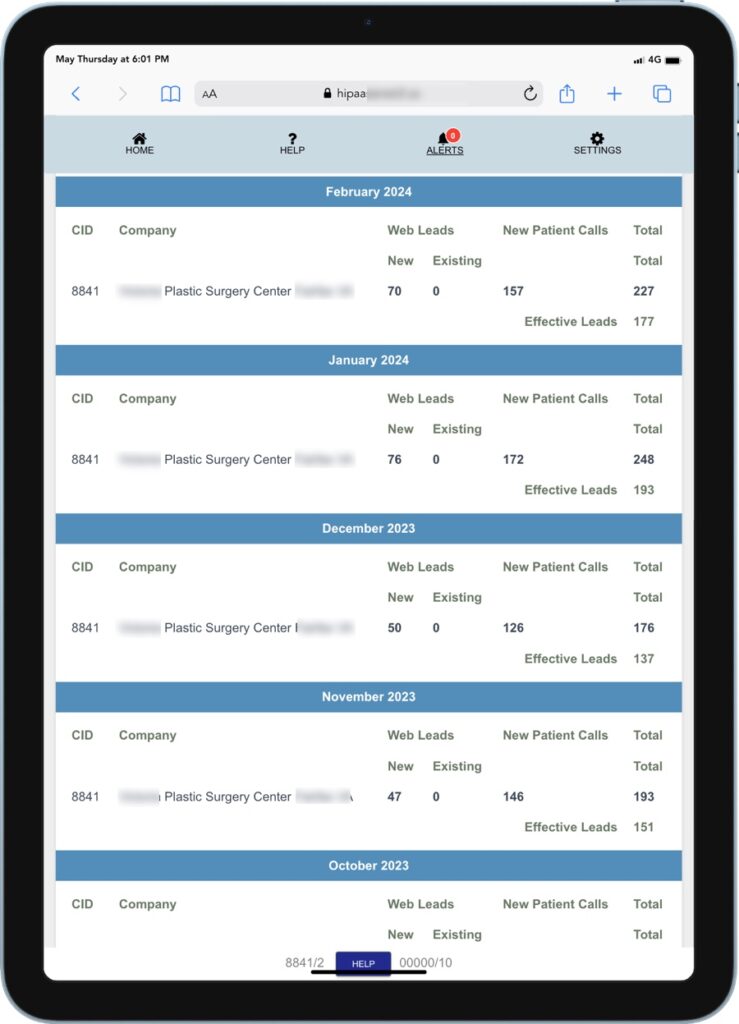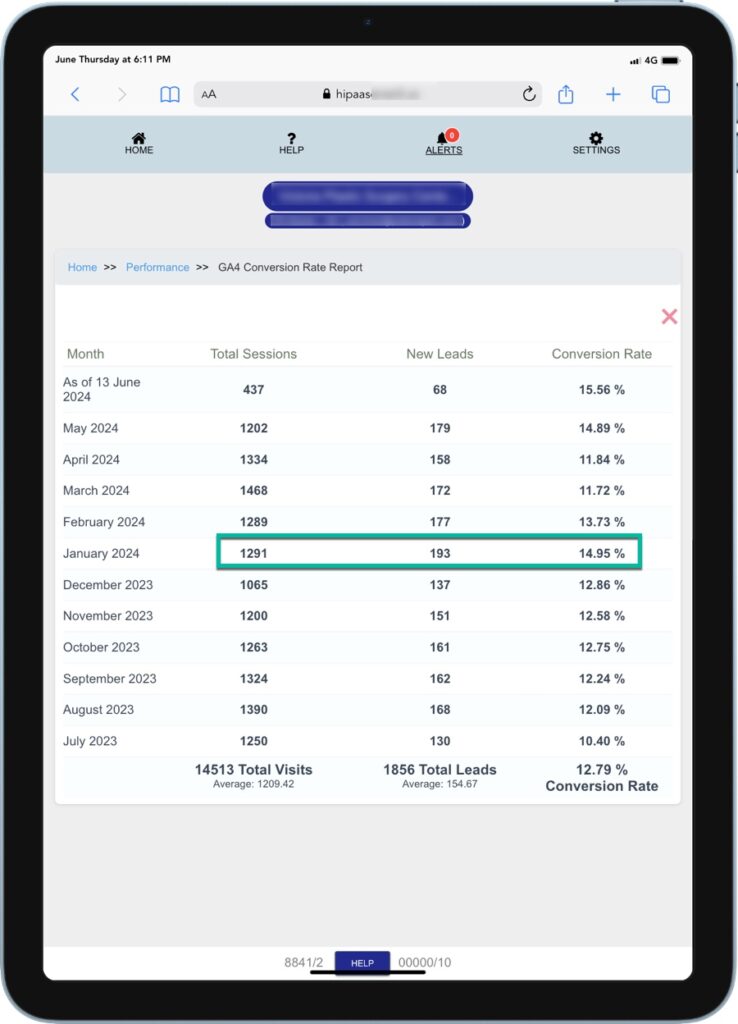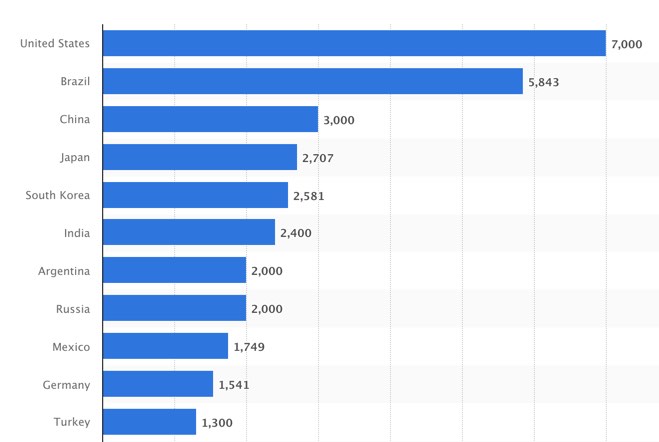$1699/Month Digital Marketing for Cosmetic Plastic Surgeons
Digital marketing company for plastic surgeons, cosmetic and aesthetics practices offers multiple services, apps and AI based social media content for higher conversion rates – Used by the top performers in USA. Hundreds of examples of successful comprehensive digital marketing, with no start-up costs.
There are more than 7000 practicing cosmetic plastic surgeons in USA alone. Followed by Brazil and China. Majority of the people believe that cosmetic and plastic surgeons simply focus on procedures related to body looks only. However this is far from the truth, as the majority of the dedicated professionals are focused on body positivity for women to feel confident, comfortable and proud of their bodies. There is no “one size fit all”.


Example 1 : Plastic Surgeon Located on the East Coast – Extremely Competitive Area.
Data: You can see that in January the plastic surgeon practice received 193 effective leads. 72 % of the leads are being generated from the SEO of the website. There are no paid ads on Google or Social Media. The conversion rate of this website is extremely high. All of these leads were generated without any ads. Ads do work, and will add more leads. Ads on Google and social media are effective.

Calculating the conversion rate of plastic cosmetic surgeon website.
In the following data, 1291 people visiting the website (excluding the bots). From these 193 new leads were generated. Most of the patients called the “new patient” phone tracking. Others booked appointments or sent a text message. This means that in this particular month, the conversion rate was 14.95 %. Average conversion rate is around 4 % . See this page for more data.

In USA and Canada, thousands of cosmetic, aesthetic, plastic surgeons struggle every month to fill their calendars with quality patients who are looking for their services. PatientGain’s digital marketing for cosmetic plastic surgeons is divided into 2 parts 1) immediate short term ROI (return on investment) and 2) long term digital presence. This is very important, because as a business owner, you should not have to depend on Google, Facebook and Instagram advertising for the rest of your life.

Steps for digital marketing success for your plastic surgery, cosmetic and aesthetics practice
First divide start term plan vs long term. But all starts with an excellent website. If you do not have an excellent website which is designed for conversion, and is A/B tested, any other efforts will produce mediocre results.
Short term steps for digital marketing for your plastic surgery, cosmetic and aesthetics practice:
Assuming that you already have a performing website, focus on these steps
- Advertising on Google PPC AdWords. This is very effective but is expensive. However, it is easy to justify ROI (return on investment) for your cosmetic and aesthetics advertising costs.
- Facebook, and instagram advertising – Youtube, TikTok are also effective.
- Start posting 2-4 times per week on Facebook, IG and Google GMB
- Setup Email marketing campaign – We recommend 2 to 3 Email campaigns per month. Focus on sending useful information to patients. Send to both potential and existing patients. Useful information means information about procedures, results, and make sure to add disclaimers.
- Add texting app to your website. What this means is that when a patient is on your website, they should be able to send you a text from your website right-away.
- Add a Chat*Bot app to your website. If setup properly, this will increase your total number of leads.
- Add call tracking on your website. Specifically, focus on tracking all new patient calls. Measure the average call time, how many calls are missed. Is your staff trained to answer the calls? Are they welcoming or are simply trying to answer calls? PatientGain’s data shows that majority of your leads will still contact you from phone calls.
- Add BMI calculator app. it is designed to capture leads for your practice.
Long term steps for digital marketing for your plastic surgery, cosmetic and aesthetics practice:
Assuming that you already have a performing website, focus on these steps
- Start improving the content of the website
- Improve the structure of the website
- Improve the speed of the website
- Hire a good medical marketing company to assist you with improving the SEO – All SEO leads are free, where as all leads that originate from Facebook, Instagram, TikTok, Google ads cost you money.
- Once you have built the SEO, and have 100+ keywords on Google’s first page with clicks, you will be a very happy cosmetic plastic surgery owner.
- Invest in a CRM
- Invest in adding atleast one new page on your website, per month. Each of these pages should be based on providing useful information about your specific procedure.
Reasons Why Repeat Plastic Surgeon Patients Are Better Than New Patients
Repeat patients in a plastic surgery practice offer distinct advantages over new patients, benefiting both the practice’s reputation and its bottom line. Here are some of the reasons why repeat patients are generally more valuable:
- Higher Lifetime Value: Repeat patients typically generate more revenue over time compared to new patients because they return for additional procedures or follow-up treatments. This increased frequency of visits contributes to a higher lifetime value.
- Lower Marketing Costs: Acquiring new patients often involves significant marketing and advertising expenditures. In contrast, repeat patients require fewer resources to retain, as the relationship and trust are already established.
- Increased Trust and Comfort: Patients who return for multiple procedures have a higher level of trust in their surgeon and the practice. This trust can lead to a more comfortable experience for both the patient and the surgeon, as well as less time spent on consultations and explanations.
- Improved Treatment Outcomes: Repeat patients give surgeons a better understanding of their medical history and aesthetic preferences, which can lead to more personalized care and improved outcomes.
- Referrals: Satisfied repeat patients are more likely to refer friends and family to the practice, expanding the patient base through trusted word-of-mouth recommendations.
- Stable Revenue Stream: Repeat patients provide a more predictable and stable revenue stream. Regular appointments and procedures help smooth out fluctuations in income and support more accurate financial planning.
- Feedback and Quality Improvement: Repeat patients are more likely to provide valuable feedback based on their experiences, helping the practice improve service quality and patient satisfaction.
- Reduced Operational Risks: New patients require significant administrative work for intake, assessments, and compliance. Repeat patients, with their information already on file and procedures familiar, reduce these operational burdens.
- Enhanced Reputation: A base of repeat patients demonstrates the high quality of care and patient satisfaction, enhancing the practice’s reputation. This can be particularly beneficial in competitive markets.
- Opportunity for Comprehensive Care: Surgeons have the opportunity to offer comprehensive, long-term aesthetic plans for repeat patients, addressing their needs over time with a holistic approach.
Focusing on retaining and satisfying repeat patients can result in more efficient operations, better patient outcomes, and a more robust business model for plastic surgeons.
Plastic surgery is an umbrella term that can include plastic surgery to improve a person’s cosmetic appearance, known as cosmetic surgery, or to fix an area of the body that has been damaged, known as reconstructive surgery. Both types of plastic surgery are handled by plastic surgeons, although some tend to specialize in one type over another kind. As of 2022, there are 7,000 plastic surgeon businesses in the United States. Many plastic surgeons use digital marketing to attract new clients. These potential clients are much more educated today on the ins and outs of plastic surgery and know what to look for in terms of quality and safety. With that in mind, a plastic surgeon must create a digital marketing plan to promote their practice and showcase their talents to a target audience.
What areas should a plastic surgeon concentrate on for their digital marketing plan?
Digital marketing is a constantly evolving concept. What worked last year may be less effective this year and is vastly different than it was 5 or 10 years ago. With that in mind, a plastic surgeon should focus on establishing your credibility and building a strong online presence with these effective digital marketing strategies. This roadmap merges winning tactics specifically tailored for both plastic surgery and cosmetic aesthetics practices:
Website Optimization:
- Content is King:
- Plastic Surgery: Craft informative content about procedures, detailing risks, benefits, recovery timelines, and patient stories with before-and-after photos (always with patient consent).
- Cosmetic aesthetics: Develop content that dives deep into your programs, showcases success stories, addresses frequently asked questions, and provides detailed descriptions of the services you offer.
- Mobile-First Design: Ensure a flawless user experience on all devices, prioritizing mobile responsiveness for optimal engagement.
- Conversion Rate Optimization: Include clear calls to action (CTAs) throughout your website, such as “Schedule a Consultation” or “Download a Free Guide,” and make sure your contact forms are user-friendly and easy to complete.
Search Engine Optimization (SEO):
- Local SEO Matters: Optimize your website content for location-based searches by including relevant city names and claiming your Google My Business listing.
- Content Marketing Magic:
- Plastic Surgery: Publish informative blog posts on procedures you offer, patient education topics, and industry advancements to establish yourself as a thought leader.
- Cosmetic aesthetics: Create content that addresses common cosmetic aesthetics concerns, explores various diet plans, provides exercise tips, and promotes healthy lifestyle choices.
- Backlink Building: Develop a backlink strategy to improve your website’s authority and search engine ranking. Collaborate with local partners, guest post on reputable health websites, or sponsor local events to earn backlinks.
Social Media Marketing: Cultivate Communities:
- Engaging Content is Key:
- Plastic Surgery: Share high-quality visuals on social media platforms, such as glimpses into consultations, facility tours, and (with patient consent) successful patient outcomes.
- Cosmetic aesthetics: Feature before-and-after photos to showcase results, share motivational quotes to inspire your audience, post healthy recipes to promote a balanced lifestyle, and host live Q&A sessions with experts to answer questions and build trust.
- Paid Advertising: Utilize targeted social media ads (Facebook, Instagram) to reach specific demographics most interested in the services you provide.
- Community Building: Foster a supportive online space by creating a group or forum where clients can share their experiences, find encouragement from peers, and connect with each other.
Additional Strategies:
- Email Marketing: Personalized Communication:
- Plastic Surgery: Develop a captivating newsletter strategy with informative content, special offers, and appointment reminders to nurture leads and keep patients engaged.
- Cosmetic aesthetics: Send personalized emails with cosmetic aesthetics tips tailored to their progress, provide advice based on their specific goals, or introduce new services relevant to their interests.
- Pay-Per-Click (PPC) Advertising: Maximize Visibility: Consider utilizing Google Ads to target specific keywords relevant to your services and leverage remarketing campaigns to reconnect with website visitors who have shown interest but haven’t converted yet.
Plastic Surgery Clinics: Ethical Considerations:
- Maintain Medical Ethics: Always adhere to all relevant medical guidelines and regulations. Avoid making misleading claims or engaging in practices that violate patient privacy.
- Focus on Patient Education: Provide informative content that educates potential patients and builds trust, establishing yourself as a credible resource in the field.
Cosmetic aesthetics practices: Leverage Video Marketing:
- Video Marketing: Enhance Engagement: Create educational video content such as exercise demonstrations, cooking tutorials featuring healthy recipes, or client testimonials to add another dimension to your marketing strategy.
Analytics and Adaptation: Data-Driven Approach:
- Track and Analyze: Utilize website analytics tools to closely monitor website traffic, conversion rates, and the effectiveness of your various marketing campaigns.
- Adapt Strategies: Regularly review the data you collect to understand what’s working well and what areas need improvement. Be prepared to refine your approach based on your findings for continuous improvement.
What are some aspects of an effective website for a plastic surgeon?
When creating a website for a plastic surgeon, SEO (Search Engine Optimization) must be a top concern. A plastic surgeon should not expect a potential patient to walk into a practice and pick up information about available services and treatments. Any new patient looking for a plastic surgeon on their own will start that decision process with a search engine query. SEO helps a plastic surgeon’s website reach the first page of results and, hopefully, be one of the top three results. Those looking for the services of a plastic surgeon will only look at the top results, and virtually no one goes past the 1st page of results to look at other pages. A plastic surgeon’s website with good SEO will have the following:
- SEO keywords spread out throughout content
- Long-tailed keywords
- Short-tail keywords
- Fast site speed
- Easy to navigate
- A navigation bar
- A responsive website that loses no functionality on desktop or mobile device
- High-quality backlinks
What kind of content should be on a plastic surgeon’s website?
A plastic surgeon should have more on their website than their name, phone number, and address. (With that said, those things should be on the footer or header of every page on the site.) A potential patient will visit a plastic surgeon’s website to learn more about them and their services. They are looking for relevant, authoritative, and trustworthy information. Search engines are also looking for good content that will make the site a more relevant choice for search engine results. Relevant and informative content about the available procedures will make it easier for potential patients to make their decisions.
In addition to site pages describing services and procedures, there are other topics to which pages should be dedicated to improving conversions. These pages will help a plastic surgeon’s practice look more legitimate and will also help improve its SEO. These pages include:
- Doctor bios
- Staff bios
- Directions Page
- Blog
- Photo Galleries
- Page with links to any news articles it has been featured in
- Any awards or certifications a practice has earned
Are before and after photo galleries effective for a plastic surgeon?
Unlike many other medical practices, a plastic surgeon can significantly leverage photo galleries to promote their practice. The visual difference between people before and after plastic surgery is usually quite noticeable, if not dramatic. Plastic surgery, by its nature, changes the aesthetic appearance of someone. The before and after photos of someone who has had a broken nose fixed will be dramatically different than the before and after pictures of someone who has suffered a sprain. Before and after photos are just as compelling, in many cases, as an online review and should be used as much as possible.
Several key things are needed to make it effective before and after photo galleries. First, a plastic surgeon needs explicit permission from the patient to post photos of them. These photos are often up close and detailed and may feature something they are uncomfortable looking at or sharing. HIPAA regulations need to be followed, or heavy fines will follow. Be sure to include descriptions of the goal and what the procedure did to achieve that goal. Written testimonials from the patient featured in these picture galleries will only enhance their effectiveness in promoting a plastic surgeon.
How can a plastic surgeon effectively use a blog on their website?
A blog is an excellent addition to a plastic surgeon’s website. First, it is unique, informative, and authoritative content that will help improve the SEO of a website. Second, it is an opportunity to engage with current and potential patients about the benefits of the services and procedures at a plastic surgeon’s practice. A practice can educate patients about these procedures to understand them better and be better informed about their health decisions. A blog is also a chance for a plastic surgeons to showcase their expertise in this area of medicine. It will help them stand out compared to their competitors, who often compete for the same audience. A challenging aspect of a blog is finding a topic and time to create exciting content. A plastic surgeons should set a pace that they can achieve. While many aesthetics companies may update a blog several times a month, this may not be practical for a smaller plastic surgery practice. Creating engaging content monthly (12 times a year) is minimum. Ideally 3 or more pages of useful content should be created every month and added to your website, for SEO. Below are some different areas a plastic surgeon could cover on their blog.
- Blogs about self-care, such as skin care or exercises
- Breakthroughs in the areas of plastic surgery
- Staff highlights and bios of new hires
- Showcase any new award or certification and what it took to earn it.
- Detailed case study of a recent procedure, with a patient’s permission.
How can a plastic surgeon use social media to get more patients to their practice?
Social media is a potent tool that plastic surgeons can use to their advantage. Unlike other medical practices, plastic surgery is a visual medical field. Changes in a person’s physical appearance can be very compelling. Images and videos often perform very well on social media and have a higher chance of being shared with friends, increasing their chances of going viral. The top social media channels a plastic surgeon should create profiles on are:
- Tiktok
- Google Business Profile
Depending on how much time they have or if they can assign someone whose sole responsibility is social media, these channels may also prove helpful:
- Snapchat
- YouTube
What content should a plastic surgeon post on their social media channels?
Deciding on what content to use on social media channels can be challenging. A plastic surgeon should always avoid “Selling” their medical practice to current and potential patients. Followers will begin to ignore posts or unfollow the profile altogether. The key to good social media posting is variety. Below are different kinds of posts you can use across social media channels:
- Announcement of special hours of operation
- Before and after pictures from patients
- Discounts or promotional events
- Contests
- Surveys
- Links to blogs
- Links to articles about healthcare topics a target audience would be interested in reading
- Invites to Livestream events
- Sharing recent reviews or testimonials
- Frequently Asked Questions
How can a plastic surgeons get more reviews and improve their online reputation to get more patients?
With new patients always doing a bit of online research before making a medical decision, a plastic surgeons need to manage their reviews. A negative online reputation will make getting new patients through the front door of a practice difficult and more expensive. A digital marketing plan working with a negative reputation will not be as effective as it could be. The more positive an online reputation, the easier it will be for a potential patient to select a plastic surgeon for their services.
The online reviews of a plastic surgeon are often the first thing a patient will see before visiting a website. Over 90% of patients use reviews to make healthcare choices. Potential patients may not even explore a website if they are immediately confronted with numerous negative reviews. With that in mind, a practice must manage and monitor any plastic surgeon’s online reputation and reviews. All reviews must responded to quickly to show new patients that feedback is valued.
How can a medical practice get more reviews?
The more reviews a plastic surgeon has, the better it will look to patients and search engines. A plastic surgeon with over 1,000 reviews will look more legitimate and established than a plastic surgeon with ten reviews. To start collecting reviews for a plastic surgeon, all a practice needs to do is ask. While not every patient will leave a review, a reliable portion will. The more that are asked for feedback, the more likely reviews will begin to accumulate. Requests via email and text messages are generally seen as the most effective ways to ask for reviews. Text messages convert better than email requests, but email requests often cost less. The review leaving process needs to be as simple as possible with as few clicks as needed. If practical, there should be only one click a patient has to make before they can start leaving a review. Every additional click will increase the chance that they will abandon the process altogether.
There are several different websites where patients can leave reviews. There are even some that are healthcare specific, like Vitals, Healthgrades, and RealSelf. However, the vast majority of reviews that other patients will see will be from:
- Bing
Google and Yelp require a practice to verify their listing via text message or postcard sent through the mail. No verification is needed for a Facebook Business Page. Google will generally receive over 70% of all reviews of these three locations throughout the year. For these listings to perform effectively, be sure that the listings are filled out. For Local SEO purposes, ensure the addresses, the practice’s name, hours of operation, services, and URLs are all accurate. It will help these profiles be found in search, make a listing look more legitimate, and help potential patient make their decisions.
What should a plastic surgeon do with a positive review?
Ideally, there should be many more positive reviews than negative reviews. A positive review should always be responded to with gratitude for the patient taking the time to leave feedback. If they mention a specific service, staff member, or something else, be sure to acknowledge that in response to show them and others that reviews are read. Do not copy and paste responses. Otherwise, people will think it is an automated reply, which hurts the authenticity of a plastic surgeon’s practice.
What should a plastic surgeon do with a negative review?
First, do not panic. Negative reviews are bound to happen. Second, do not threaten the reviewer with legal action in an attempt for them to revise the review. These lawsuits never work and often bring negative attention to the medical practice that attempts it. Patients usually want to be heard, and a plastic surgeon’s job is to try to listen to them. Before responding, try to determine who the person is and contact them to see if their issue can be sorted out and rectified. If they refuse to answer the phone or a practice can not determine who the reviewer is, leave a response asking them to call the practice. Potential patients looking at reviews will show them that a plastic surgeon takes feedback seriously and will do their best to fix any problems.
Are there any offline or traditional marketing methods a plastic surgeon can use to get more patients?
Traditional and offline marketing methods have fallen by the wayside for many plastic surgeons, who have concentrated more on digital marketing. However, traditional marketing strategies can still be quite effective. With that said, TV, Radio, and Newspaper advertising may not be a good choice for many plastic surgeons. These mediums are expensive and do not allow for a lot in the way of targeting. However, direct mail marketing can let a plastic surgeon target by address, zip code, neighborhoods, and mailing routes. The US Postal service has various tools for plastic surgeons to use to help with a direct mail marketing campaign. Discounted postage is even available if certain volume and presorting benchmarks are met.
Anything mailed to a household must catch the attention of the person checking the mail, or it will end up in the trash. A plastic surgeon should experiment with messaging, brand colors, size, texture, and call to actions to find the most effective combination for the campaign a practice wants to launch for potential patients. Every piece of direct mail marketing material should have the following:
- Name of the plastic surgeon’s practice
- The physical address, including any suite numbers
- Most popular services offered
- Phone Numbers
- Site URL
- Call to action
The experts at PatientGain.com are available to help you create a high-performance healthcare website for a plastic surgeon’s practice. Contact us today, and let us show you what we have done for other practices across the country!
